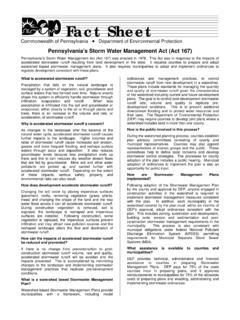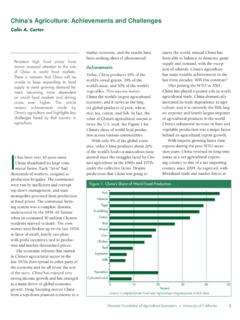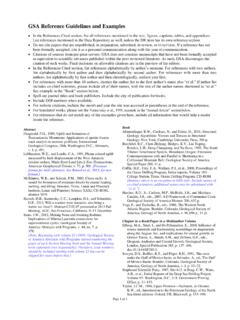Transcription of BMP 6.4.2: Infiltration Basin - StormwaterPA
1 Pennsylvania Stormwater Best Management Practices Manual Chapter 6 BMP : Infiltration Basin An Infiltration Basin is a shallow impoundment that stores and infiltrates runoff over a level, uncompacted, (preferably undisturbed area) with relatively permeable soils. Potential ApplicationsResidential: Commercial: Ultra Urban: Industrial: Retrofit: Highway/Road:Yes Yes Limited Yes* Yes Limited* Applicable with specific consideration to FunctionsKey Design ElementsVolume Reduction: Recharge: Peak Rate Control: Water Quality:High High HighWater Quality FunctionsTSS: TP: NO3: 85% 85% 30% Maintain a minimum 2-foot separation to bedrock and seasonally high water table, provide distributed Infiltration area (5:1 impervious area to Infiltration area - maximum), site on natural, uncompacted soils with acceptable Infiltration capacity, and follow other guidelines described in Protocol 2.
2 Infiltration Systems Guidelines Uncompacted sub-grade Infiltration Guidelines and Soil Testing Protocols apply Preserve existing vegetation, if possible Design to hold/infiltrate volume difference in 2-yr storm or storm Provide positive stormwater overflow through engineered outlet structure. Do not install on recently placed fill (<5 years). Allow 2 ft buffer between bed bottom and seasonal high groundwater table and 2 ft buffer for rock. When possible, place on upland soils. Other Considerations Protocol 1. Site Evaluation and Soil Infiltration Testing and Protocol 2. Infiltration Systems Guidelines should be followed, see Appendix C 363-0300-002 / December 30, 2006 Page 27 of 257 Pennsylvania Stormwater Best Management Practices Manual Chapter 6 Description Infiltration Basins are shallow, impounded areas designed to temporarily store and infiltrate stormwater runoff.
3 The size and shape can vary from one large Basin to multiple, smaller basins throughout a site. Ideally, the Basin should avoid disturbance of existing vegetation. If disturbance is unavoidable, replanting and landscaping may be necessary and should integrate the existing landscape as subtly as possible and compaction of the soil must be prevented (see Infiltration Guidelines). Infiltration Basins use the existing soil mantle to reduce the volume of stormwater runoff by Infiltration and evapotranspiration. The quality of the runoff is also improved by the natural cleansing processes of the existing soil mantle and also by the vegetation planted in the basins. The key to promoting Infiltration is to provide enough surface area for the volume of runoff to be absorbed to meet the criteria in Chapter 3.
4 An engineered overflow structure should be provided for the larger storms. 363-0300-002 / December 30, 2006 Page 28 of 257 Pennsylvania Stormwater Best Management Practices Manual Chapter 6 Variations z Re-Vegetation For existing unvegetated areas or for Infiltration basins that require excavation, vegetation may be added. Planting in the Infiltration area will improve water quality, encourage Infiltration , and promote evapotranspiration. This vegetation may range from a meadow mix to more substantial woodland species. The planting plan should be sensitive to hydrologic variability anticipated in the Basin , as well as to larger issues of native plants and habitat, aesthetics, and other planting objectives.
5 The use of turf grass is discouraged due to soil compaction from the required frequent mowing and maintenance requirements. z Usable Surface An Infiltration Basin can be used for recreation (usually informal) in dry periods. Heavy machinery and/or vehicular traffic of any type should be avoided so as not to compact the Infiltration area. z Soils with Poor Infiltration Rates A layer of sand (6 ) or gravel can be placed on the bottom of the Infiltration Basin , or the soil can be amended to increase the surface permeability of the Basin . (See Soil Amendment & Restoration BMP for details.) Applications z New Development Infiltration Basins can be incorporated into new development. Ideally, existing vegetation can be preserved and utilized as the Infiltration area.
6 Runoff from adjacent buildings and impervious surfaces can be directed into this area, which will water the vegetation, thereby increasing evapotranspiration in addition to encouraging Infiltration . z Retrofitting existing lawns and open space Existing grassed areas can be converted to Infiltration basins. If the soil and Infiltration capacity is determined to be sufficient, the area can be enclosed through creation of a berm and runoff can be directed to it without excavation. Otherwise, excavation can be performed as described below. z Other Applications Other applications of Infiltration Basins may be determined by the Design Professional as appropriate. Design Considerations 1. Soil Investigation and Infiltration Testing is required; site selection for this BMP should take soil and Infiltration capacity into consideration.
7 2. Guidelines for Infiltration Systems should be met ( , depth to water table, setbacks, Loading Rates, etc.) 3. Basin designs that do not remove existing soil and/or vegetation are preferred. 363-0300-002 / December 30, 2006 Page 29 of 257 Pennsylvania Stormwater Best Management Practices Manual Chapter 6 4. The slope of the Infiltration Basin bottom should be level or with a slope no greater than 1%. A level bottom assures even water distribution and Infiltration . 5. Basins may be constructed where impermeable soils on the surface are removed and where more permeable underlying soils then are used for the base of the bed; care must be taken in the excavation process to make sure that soil compaction does not occur.
8 6. The discharge or overflow from the Infiltration Basin should be properly designed for anticipated flows. Large Infiltration basins may require multiple outlet control devices to effectively overflow water during the larger storms. See BMP for more information on overflows and berms. 7. The berms surrounding the Basin should be compacted earth with a slope of not steeper than 3:1(H:V), and a top width of at least 2 feet. 8. At least one foot of freeboard above the 100-year storm water elevation should be maintained. 9. Infiltration basins can be planted with natural grasses, meadow mix, or other woody mixes, such as trees or shrubs. These plants have longer roots than traditional grass and increase soil permeability.
9 Native plants should be used wherever possible. 10. Use of fertilizer should be avoided. 11. The surface should be compacted as little as possible to allow for surface percolation through the soil layer. 12. When directing runoff from roadway areas into the Basin , measures to reduce sediment should be used. 13. The inlets into the Basin should have erosion protection. 14. Contributing inlets (up gradient) may have a sediment trap or water quality insert to prevent large particles from clogging the system based on the quality of the runoff. 15. Use of a backup underdrain or low-flow orifice may be considered in the event that the water in the Basin does not drain within the criteria in Chapter 3. This underdrain valve should remain in the shut position unless the Basin does not drain.
10 Detailed Stormwater Functions Infiltration Area The loading rate guidelines in Appendix C should be consulted The Infiltration Area is the bottom area of the bed. 363-0300-002 / December 30, 2006 Page 30 of 257 Pennsylvania Stormwater Best Management Practices Manual Chapter 6 Volume Reduction Calculations Volume = Depth* (ft) x Area (sf) *Depth is the depth of the water stored during a storm event, depending on the drainage area and conveyance to the bed. Infiltration Volume = Bed Bottom Area (sf) x Infiltration design rate (in/hr) x Infiltration period* (hr) x (1/12) * Infiltration Period is equal to 2 hours or tne time of concentration, whichever is larger.










